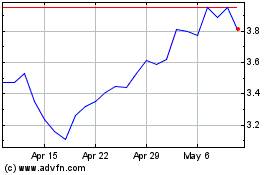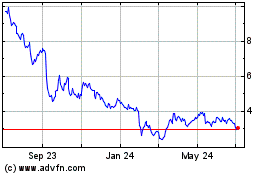IHS Report: Future Viability of Solar Photovoltaic Technology Dependant on Production Cost Improvements
January 24 2011 - 3:15PM
Business Wire
During 2010, new solar photovoltaic (PV) demand worldwide
approached 10,000 MW, and is expected to grow by double digit
percentages annually for the foreseeable future, if production
costs can be driven to market-competitive levels. In response to
interest in photovoltaics for industrial and utility scale power,
SRI Consulting, now part of IHS Inc. (NYSE: IHS), examines the
economics for producing solar cells from three dominant commercial
process technologies – monocrystalline wafers (Sunpower), CdTe
thin-film (First Solar) and concentrating PV (Concentrix) – in its
new techno-economic analysis report entitled Solar Photovoltaic
Technology.
In the U.S. and other regions, utility commission renewable
power portfolio requirements dictate that specific amounts of grid
power be sourced using technologies that do not produce greenhouse
gases. As a result, several utilities are now considering
supplementing conventional power (nuclear, coal and natural gas)
with a combination of wind power, biomass power, solar thermal and
solar photovoltaic power.
Demand growth for PV power in the early 2000s averaged 40
percent per year, driven by a combination of technology
advancements and generous government subsidies – especially in
Spain and Germany – in the form of feed-in-tariffs. The global
economic recession of 2008 - 2009 all but eliminated growth, but
early 2010 saw demand begin to turn around.
Photovoltaic power is well suited to distributed demand
applications where its devices can be mounted on residential
homeowner rooftops (< 5 kw capacity), and on small commercial
buildings (< 50 kw). Advancements in both manufacturing
technology and engineering and design practices are also reducing
the cost of ‘balance of system’ components required for the
consideration of PV power at utility scale (> 5 MW) at economics
approaching conventional peaking power cost (grid parity).
“Advances in technology have significantly improved cost
competitiveness, but the commercial world still relies heavily on
government subsidies,” said Solar Photovoltaic Technology author
and IHS Principal Consultant Anthony Pavone. “Like other renewable
energy technologies, societal concerns over greenhouse gas-caused
climate change provide the justification for these subsidies.”
Although the integrated product chain can be considered as
starting with mined silicon metal, and terminating with a
combination of PV modules sold to end-use customers, and turnkey
power plants sold to utility customers, the heart of the business
is in producing PV cells, mounting them in modules (sometimes
called panels) rated at 70 – 400 watts, and installing arrays of
modules to satisfy customer requirements. A globally competitive
producer requires a capacity base of 500 MW/year, and that a
utility scale PV plant will have a capacity of 10 – 50 MW.
Two forms of cell architecture, silicon-based wafer and
thin-film technologies, dominate the business, with 80 percent and
20 percent market share respectively. Solar Photovoltaic Technology
estimates production economics for the two manufacturing approaches
and, using producer-specific information (patents, trade
literature, technical publications and business presentations),
provides reasonable design basis assumptions. These results are
then used to estimate the economics of a PV utility power plant
with a 50 MW capacity.
Added to the analysis are speculative economics based upon the
limited capacity operating experience of concentrated PV producers
Cogentrix in Spain and Innovative Solutions in the U.S. These
economics, although not cost competitive with most conventional
base load power generation ($0.04 - $0.08 per kwh), are close
enough to compete with peaking electric power in most business
environments, and with base load electric power in high cost power
regions, including Denmark, Italy and California.
“As PV technology improvements reduce cost faster than
conventional technologies reduce cost, the world is likely to soon
see an environment where PV subsidies are no longer necessary,”
added Pavone.
For additional information on Solar Photovoltaic Technology,
contact RJ Chang, at rj.chang@ihs.com or +1 650 384 4307, or visit
www.sriconsulting.com/PEP.
About SRI Consulting
(www.sriconsulting.com)
SRI Consulting is now part of IHS Inc., and is the world’s
leading business research service for the global chemical industry.
Publishing for over 60 years, SRI Consulting is the preeminent
source for in-depth business and process analysis.
SRI Consulting (SRIC) is a trade name and a registered trademark
of SRI International, used under license.
About IHS
(www.ihs.com)
IHS (NYSE: IHS) is a leading source of information and insight
in pivotal areas that shape today’s business landscape: energy,
economics, geopolitical risk, sustainability and supply chain
management. Businesses and governments around the globe rely on the
comprehensive content, expert independent analysis and flexible
delivery methods of IHS to make high-impact decisions and develop
strategies with speed and confidence. IHS has been in business
since 1959 and became a publicly traded company on the New York
Stock Exchange in 2005. Headquartered in Englewood, Colorado, USA,
IHS employs more than 4,400 people in more than 30 countries around
the world.
IHS is a registered trademark of IHS Inc. All other company and
product names may be trademarks of their respective owners.
Copyright © 2011 IHS Inc. All rights reserved.
IHS (NYSE:IHS)
Historical Stock Chart
From May 2024 to Jun 2024

IHS (NYSE:IHS)
Historical Stock Chart
From Jun 2023 to Jun 2024
